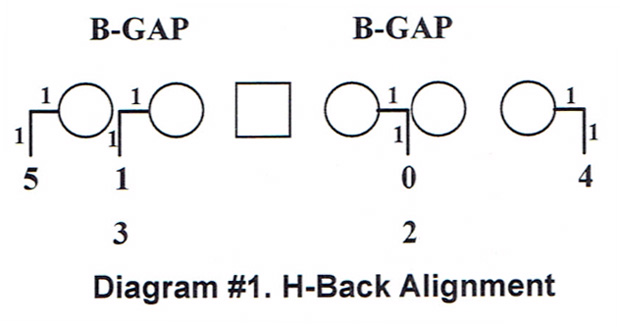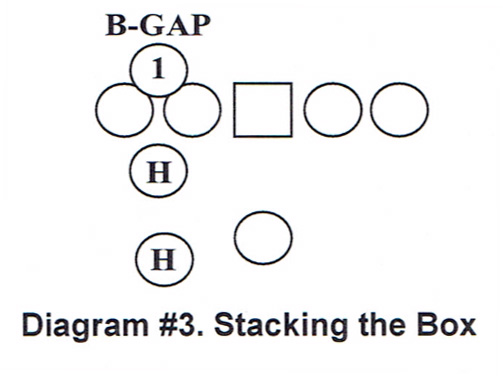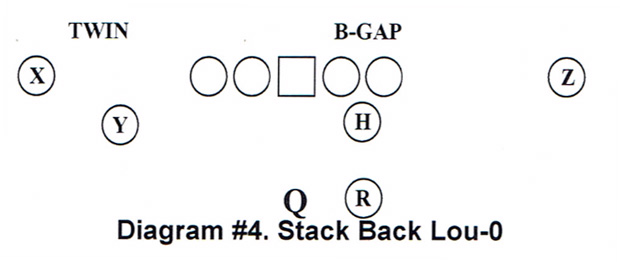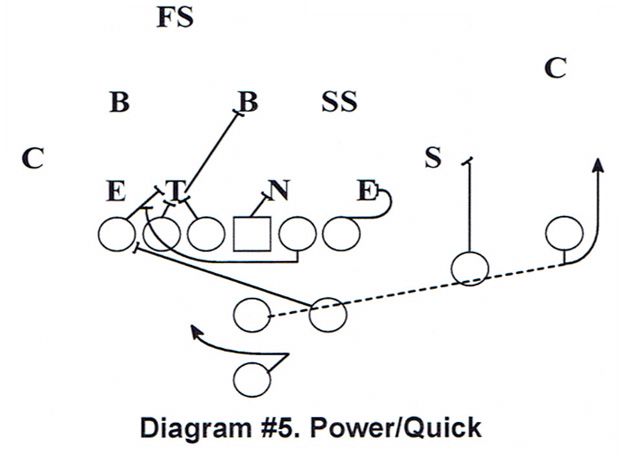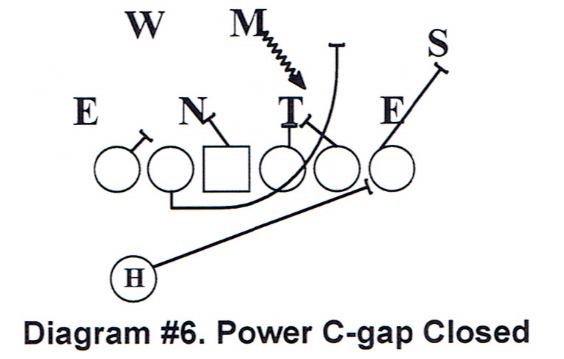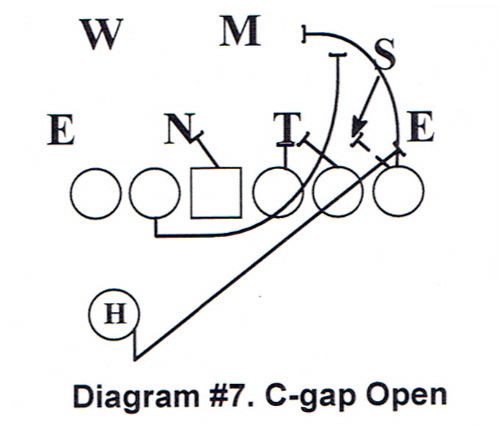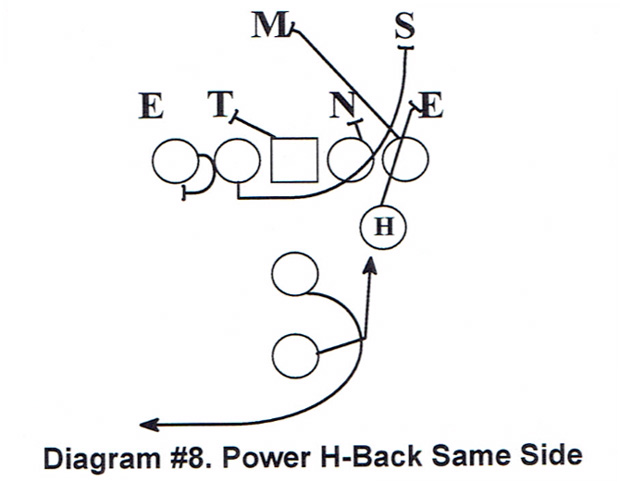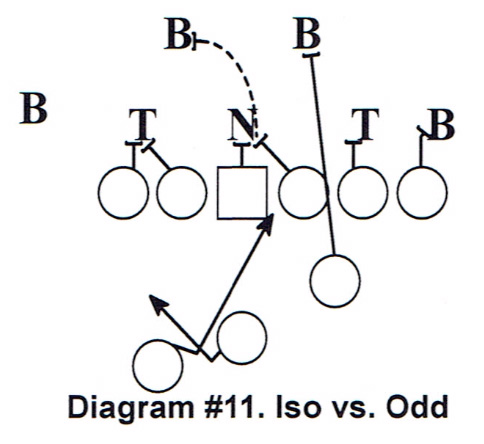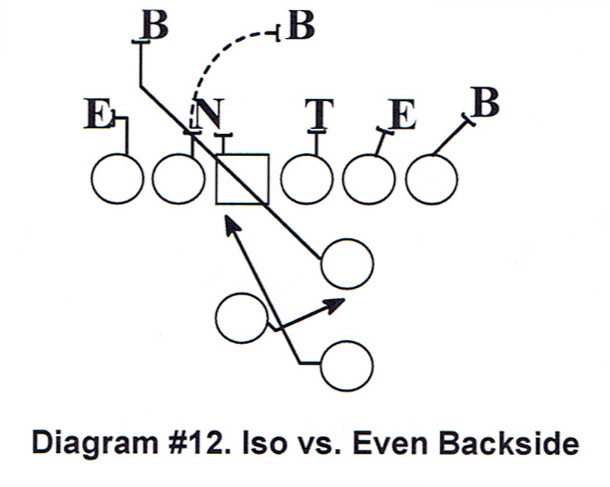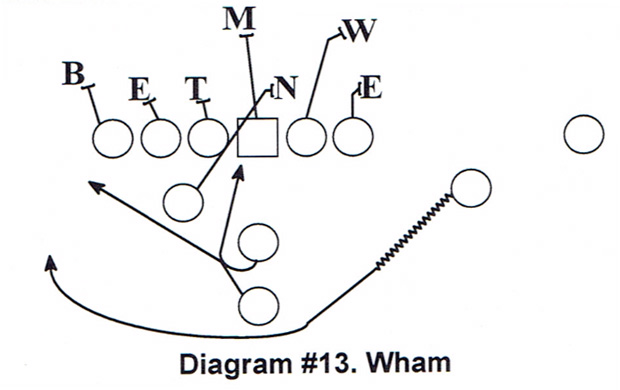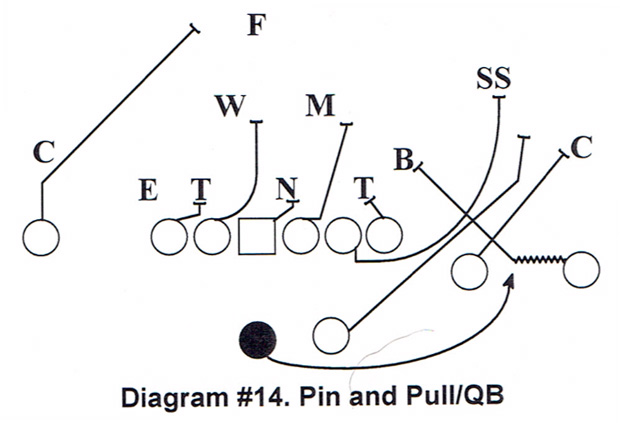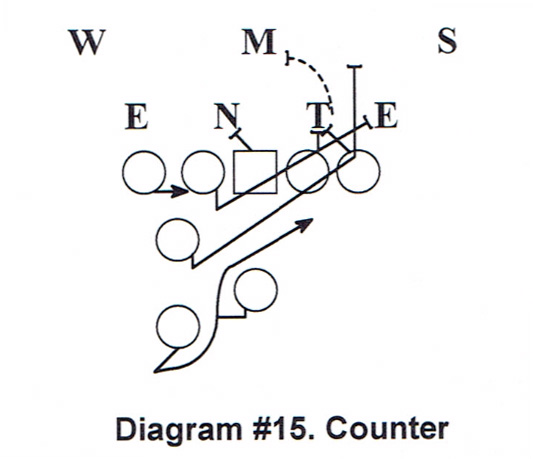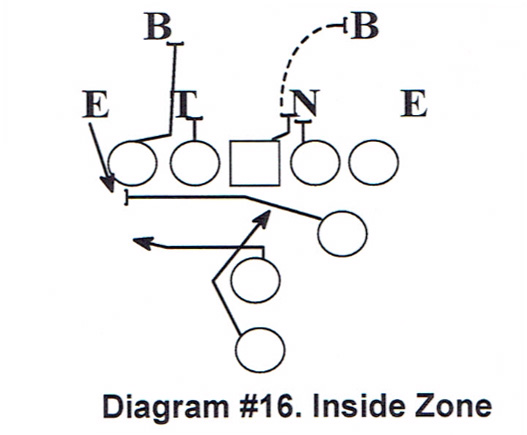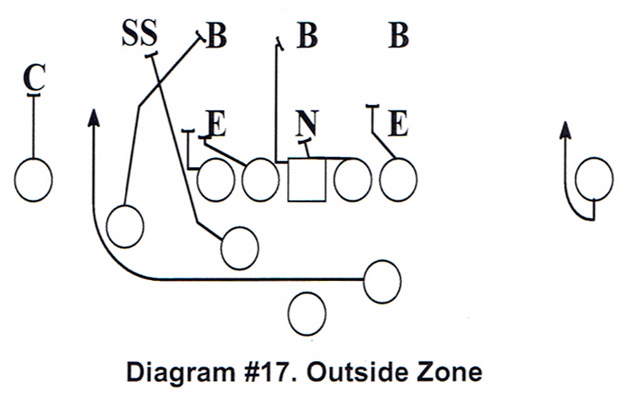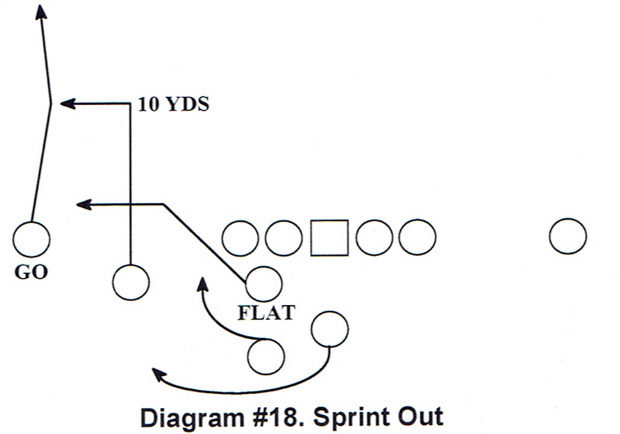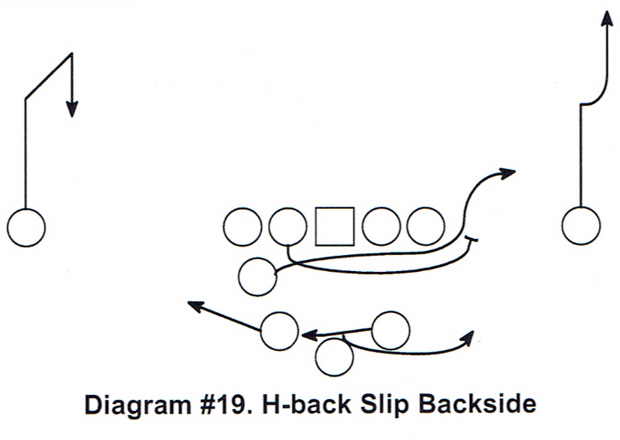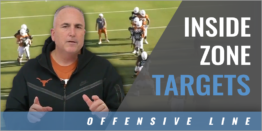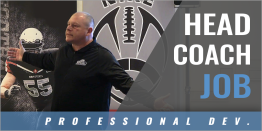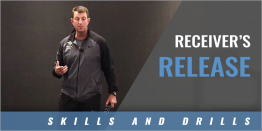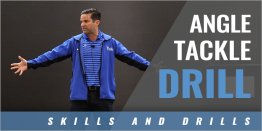| Effective Use of H-Back Concepts |
| By: James Vint - Seminole High School (TX)
Originally Published in: Nike 2016 Coach of the Year Clinic Notes - Earl Browning Provided by: Nike Coach of the Year The Foundation • Based on the I-formation in the mid 90's • Ran multiple options and traditional concepts • Added the shotgun and zone read principles in 1999 • Evolved to multiple pro-style offense based out of the pistol but still got under the center to run the downhill running game • Discovered we could run our downhill running concepts. read game. and option concepts without being under the center • H-back gave us the ability to add gaps and put the defenders into conflict I am going to talk to you today about doing more with not quite as much as the next guy. We evolved from the I-formation into the spread and from there into the pistol. Once we did that we were able to marry our downhill run game with our spread concepts. We did all that without having to get under the center. I can teach my quarterback to take a three-step drop easier than I can the five-step drop. Our Philosophy on Offense • We want to be simple in our concepts but multiple in our presentation • Use multiple tempos to keep the defense off balance • Limit our concepts to increase quality repetitions • Play physical football in the box • Use RPO's to force the defense to defend all 53 yards of width and account for each skilled player every play The football games we win are the games where we run three run concepts. We run multiple tempos in our scheme. The first game of the year we snapped the ball 34 times in the first quarter. We went fast. At practice, we limit the concepts so we can get quality repetitions. Football is a physical game. You cannot win if you are not physical. When we went through our evolution, we had questions about how to use the H-back. H-Back Concepts • Our H-back is a hybrid player. he can play tight end. wide receiver, or fullback • Typically. he is a bigger skill player • Must be able to block (number one job) • Has to understand leverage and get to the leverage point • We want a tough kid with decent quickness • Ideally - can align in multiple positions on the field and catch the ball Everywhere I have been we have been blessed with tight ends. We need to find a way to get more of them on the field. We want to get leverage on the defense. outnumber them at the point of attack, and get our playmaker the ball. This year we had three prospects at tight end. We are looking for is a player that can block. He has to be unselfish and every once in a while. he will get to catch the football. They have to be tough kids and understand the leverage point. When we talk to them about leverage point. we are talking about the point at which we have leverage on the defender. We teach them to gain the leverage on a defender with their feet. Personnel Groupings • Our goal is to go from three backs to empty with multiple personnel groups • Defensive coordinators often make their calls on personnel groups • Our ultimate goal is to have a player who is versatile to line up in the backfield as an H-back or an inside receiver In our offense we use five personnel groups. We use 20 21. 10. 11. and 12. We very seldom play without a running back in the game. but we can. We want to have a player that can line up as a tight end. and line up in the backfield as well. If we can do that what do we gain? What We Gain from an H-back Alignment • We create an extra gap • We get leverage on kick out blocks • The defense must defend the H-back as a blocker and receiver • Our H-back can block either front side or backside and we align him To or Away from the side he will be blocking The big deal is he can align on the left side and block across the formation on the right side. Communicating the H-back Alignment • X and Z are wide receivers. X to the left and Z to the right • We communicate R and L to align the Y-tight end • Rip/Liz: Y aligns as tradition tight with a hand on the ground • Ron/Lou: Y aligns as a twin • R/L: Y aligns as a slot 1 X 1 from the offensive tackle • Ricky/Lucy: Y aligns as tight end with a hand down opposite the X and Z • Use numbers to align the H-back (even to the right - odd to the left) If we have a right call. the tight end goes to the right, and the H-back is the adjuster. (Diagram #1) We have a coach to signal that to the H-back. We use a body clock for the alignment. If we want him in a 0-position, we signal him with a closed fist. His 0-alignment is 1 yard by 1 yard off the hip of the offensive right guard or in the B-gap. The corresponding number position is 1. which is the same position to the left. On the body clock that signal is the right eye.
On the body clock we start with the head. Zero is the closed fist. One is the right ear or eye, two is the nose. and three is the left eye or ear. We do the same thing across the chest and hips. The right shoulder is number 4, middle of the chest is 5. and the left shoulder is 6. We always go from right to left across the body. The 4-5 position is a wing set 1 X 1 outside the last offensive lineman. If we call 2-3. he is next to the quarterback in the offset position. The H-back can align outside the box. (Diagram #2) The wider the H-back aligns the higher the number. The even numbers are to the right and the odd numbers to the left. The 6 and 7 alignments are wide slot positions and the 8 and 9 are wide receiver alignments. You can align the H-back in a 6-alignment and motion him back into the box.
We can move the H-back around the field and it is a simple system. We have one coach signaling the X, Y, and Z. and another coach signaling the H-back and tailback. We can use motion and align the H-back outside the box and motion him into the box. The defense has to adjust to account for the extra blocker. You can get the defense to align to a one-back formation and motion into a two-back formation. The verbiage used to call the plays has changed from five and six words to a single or no more than two words. We can stack in the box with the H-back and running back. (Diagram #3) If you stack in the box, it gives the defense an additional gap to play. They must play inside and outside the stack. The communication to the running back is a single signal. We give the H-back a 1-alignment and the running back has a weak offset alignment.
I want to show you an example of our formation calls. If we call Lou. that sets the Y-end in a twin position to the X-receivers side. (Diagram #4) If we add 0 to the call. that sets the H-back in the B-gap to the right. The call is -Lou-0." Another look we used this year was a fullback and running back with an H-back.
I want to talk about our running concepts in our offense. We run power, isolation, trap/wham. buck sweep. counter, and pin and pull. This is in addition to the zone plays. We do not run all these concepts every year. This year we ran the power and isolation from the gap scheme. Two years ago we ran many wham plays. It changes from year to year as our personnel changes. We run the plays that fit what we can be good at running. We ran the gap scheme when we felt our offensive line was good as one-on-one blockers. We could block down and negate penetration. RPO's Concepts • Force the defense to defend the entire width • Defense must defend all skill players every down • Never want to be in a situation where you are running into a loaded box • Gives the offense an -out" • Gets your skill players more touches We do not call a run play that does not have a pass attached. On every running play our quarterback can throw the ball. In one game last year we threw the ball 41 times. Of those 41 only two of them were down the field. They were all short quick throws. We have the ability to do it and we can make adjustments as we go. We cannot allow the defense to load the box and not pay for it. The wide receivers still block, but it is a different type of blocking and the catch the ball more. An example of what I am talking about is the defensive alignment to this set. (Diagram #5)
We align in a Lucy. which is the tight end to the backside of a twin set. The X and Z receivers are to the same side. The H-back is in a 2-position to the right of the quarterback and the tailback is in the pistol position behind the quarterback. We are running power left to the tight end. The quarterback sees the X-receiver has leverage on the Sam linebacker and the corner is 9 yards off the Z-receiver. The quarterback throws the ball to the Z-receiver on a quick screen. We are looking for four yards on the play and we got eight. The offensive line ran power left and were not aware the ball was being thrown. We have rules for the wide receiver on all inside runs. If there is one wide receiver and he has access, he runs a five yard stop route. If there are two wide receivers to the side. they run the quick screen. If there are three receivers. they run the bubble screen. That is on every running play except when we call a tag or special play. If the running play is an outside play, the front side receiver blocks for the run and the backside receiver runs the RPO's. Gap Tight End Blocking Rules • If the tight end has a down defender in the C-gap, he blocks the first shirt outside • If the C-gap is open. the tight end blocks down to the next linebacker I want to show you the power with the H-back in the game. On this play the C-gap is closed. The tight end blocks outside. (Digram #6)
The H-back is the kick out blocker on this play. He comes across the set and kicks out the defender in the C-gap. In this case. the defender is a 7-technique defender playing on the inside shoulder of the tight end. The backside guard pulls and turns up at the first vertical gap. He is looking for the Mike linebacker. If the C-gap is open the tight end blocks down to the next linebacker. (Diagram #7) He skips the Sam linebacker unless he blitzes the C-gap. Otherwise the tight end is going to the Mike linebacker. The H-back kicks out the 9-technique end. The backside guard pulls and blocks the Sam linebacker. If the Sam linebacker blitzed. the tight end blocks him down and the guard blocks the Mike linebacker.
We can run this play from any of the H-back positions. On this play he kicks out the first defender past the playside offensive tackle. If we stack the backs to one side. the defense has to defend those gaps. From the stack set. we can run the power away from that formation. We align with the H-back in a 0-position in the right B-gap. with the tailback stacked behind him, we can run the power left applying the gap blocking rules. The H-back kicks out the 5-technique defensive end and the guard pulls inside looking for the linebacker. Everyone else blocks gap power rules.
We can give the quarterback a formation call, and play call with a check with me added. That allows him to go from one side of the defense to the other side running the same play. We can get all that done and snap the ball with 24 or more seconds left on the play clock. If we are going at our fastest pace, we can do it with 33 seconds left on the play clock. The running back on power plays has to understand the play is an A-gap play. He cannot bounce the ball to the outside. He has to run inside with the ball. It could hit in the B-gap, but it is not going outside. On the 3-3 stack defense, we have great angles. (Diagram #9) The playside guard and tackle block down on the middle stack. The guard blocks the nose and the tackle takes the linebacker. The center fires on the nose and comes off backside for the backside stacked linebacker.
The tight end and backside tackle base block on the 5-technique and the walked up safety. The H-back kicks out the defender in the C-gap and the guard pulls for the outside linebacker. If the guard and H-back run the play correctly. they should be hip to hip coming down the line. The H-back kicks out and the guard turns up. Same Side Power • The running back aligns slightly deeper than the quarterback and tightens his alignment • Drop step to the quarterback on the snap • Get eyes on convoy • Every gap is in play - defense cannot get away with leaving a gap free Our base alignment for the running back is in the pistol. If he runs the power. he takes a gather step to the side of the power and gets downhill to the A-gap. However, he is in the offset position many times. He has to be able to get back into the track as if he were in the pistol. If he is right of the quarterback and needs to get to the left A-gap, he takes a flat step to the quarterback and gets downhill at the outside leg of the center. If he is offset to the same side as the play, he aligns slightly deeper and flat steps to put him back in the alignment with the pistol and gets downhill to the A-gap. The alignment adjustment is so slight, the defense will not notice it. If they do notice it, we are going so fast, they do not have time to relay it to the rest of the defense. #10) On this particular play we use jet motion. The set is Ricky, which puts the tight end opposite the twin set. The slot comes in jet motion to the quarterback. We have the running back and H-back stacked in the tight end's B-gap. We run power to the left with the quarterback carrying the ball after the fake to the jet motion.
This is a tough play to defend because there are so many moving parts to the play. The next gap concept is the "Iso" play. Iso • Downhill run isolating the Mike or playside linebacker • We want to run it in the B-gap • Get a double team at the point of attack • With the H-back it is tougher for the playside linebacker to blow the play up in the backfield The Isolation play is better with the H-back blocking from his 0-position than the fullback coming from the fullback position. (Diagram #11) The linebacker can blow up the fullback on the offensive side of the line of scrimmage on an Isolation run from a backfield set. With the H-back one yard off the line of scrimmage, the linebacker cannot come from four yards away and stuff the ball in the backfield.
The tackle and tight end turn out on their defenders. The playside guard doubles with the center on the nose to the backside linebacker. The backside guard and tackle double on the backside 3-technique. The H-back comes through the B-gap and isolates the linebacker. We can run the play to the backside. (Diagram #12) The playside tackle turns out on the 5-technique end. We double the 1-technique defender to the backside linebacker. The backside base blocks. The H-back takes an angle at the rear of the playside double team block and turns up into the hole to isolate the linebacker. The running back is aligned opposite the play and makes his flat step to get into position and runs the isolation play following the H-back. He breaks off the block of the H-back.
If the running back is in the pistol, it makes it a better play. The quarterback can open either way to the running back. It all depends on who we are reading in that game. We spend five minutes in the fall running a drill called "You Got Mine, I Get Yours." We take the fullback and the guard and switch blocks. If the guard blocks the man the fullback was supposed to block, the fullback blocks the guards man. In Bum Phillips language, "If He'is blocking' Your'en, You'er blocking' His'en." We revisit that scheme during the season. The thing we want the quarterback to do on the Isolation is to ride the running back. That gives the impression he is reading someone and slows down the play of the defense. On some occasions. they are gap exchanging on read plays and this ride may confuse them. Ball security is a big deal with us. We fumbled four times the entire season and lost two of them. We bring the slot in motion and fake the read option to the tight end side. (Diagram #13) We run the -wham" with window dressing. You can run any kind of motion. Everyone on the offensive line base blocks the defender over them, except the center. He blocks the Mike linebacker. The H-back traps the 1-technique.
We can also run the play with the quarterback carrying the ball. If we run it with the jet motion fake. it breaks the same way. Pin and Pull and Buck Sweep • You to get great angles and an extra blocker • Motion can help you get speed on the edge • You can run one or both of these concepts • These are great concepts to run with your quarterback as well On the "pin and pull" play, we bring motion from the outside and crack the last man on the line of scrimmage. (Diagram #14)
The tight end blocks down on the man covering the tackle and the tackle pulls for the outside. The H-back is in a 4-position winged outside the tight end. He has a man over him, but his rule is to block the alley defender. The motion from the outside blocks the man over him. The tackle. H-back, and running back lead the quarterback to the edge. Everyone else reaches to the playside. Counter • Front side blocks gap away • Backside guard pulls and kicks out in C-gap • Backside tackle pulls, leads through the hole • The H-back pull and lead through The counter play for the offensive line is the power play. (Diagram #15) The difference is the guard is the kick out blocker and the H-back or tackle is the wrap blocker for the linebacker.
The inside zone play is a simple play to run. (Diagram #16) On this play we are not reading the backside defensive end. We are using the H-back to seal the backside. There is no read. The line blocks the inside zone with the center and playside guard combo blocking the 3-technique defender to the Mike linebacker.
If we align the H-back inside, it does not mean he cannot go outside. (Diagram #17) We align him in the 1-position to the left. He is the lead blocker on the outside zone play left. The wide receivers on the outside zone are blocking the perimeter to their side.
The inside receiver cracks on the first linebacker to the inside. The H-back is the lead blocker and the back stretches the ball to the sidelines. The offensive line to the backside reach to the playside. The playside tackle reaches, and the playside guard helps him if there is no threat. The motion we run with the outside zone play is jet motion. We like to run it because it gives us a running start to the outside. Adding Pass Concepts to the H-back • When we stack the H-back we have what becomes a trips formation • We can -hide- the H-back in our offense • We can slide the H-back across the formation and slip him out the back door • The H-back can run any of our pass routes I want to cover a few points in the pass game. When we set the H-back in the backfield. the defense has to account for him. In this set, we run the sprint out and flood route with the H-back going to the flat. (Diagram #18)
The number-1 receiver runs a Go route, the number-2 receiver runs a 10 yard Out pattern and the H-back runs the Flat. The quarterback sprints outside and reads -Out" to Flat. We like to bring the H-back behind the line and slip him out the backside. (Diagram #19) With two backs in the backfield we can get a good outside zone fake and bring the quarterback out on what looks like a waggle pass.
What we have done with success is run the Wildcat set with our best back at the quarterback position. He can run the isolation and power from that set and it has been effective for us. If you are ever out our way. drop in and see us. Thank you very much for your time. |



